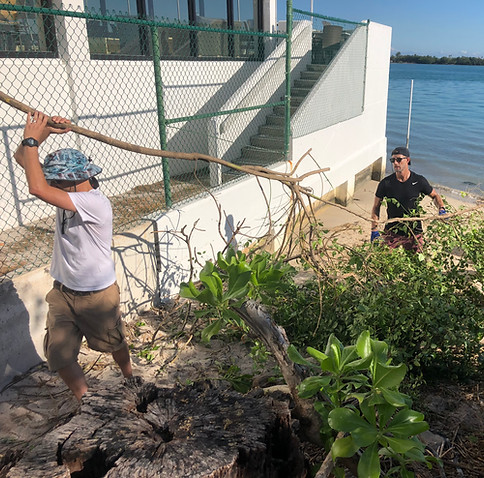The Evolution of Darwin Beach

Ever-growing and expanding, the invasive and exotic vegetation currently inhabiting Darwin Beach – such as Beach naupaka Scaevola taccada, Latherleaf Colubrina asiatica, and Australian Pine Casuarina equisetifolia – have not only prohibited the native species such as Seagrape Coccoloba uvifera and Green Buttonwood Conocarpus erectus from surviving, but have completely disrupted the beach ecosystem.
Starting in 2019, with the help of the University of Miami's Rosenstiel School - along with Miami Seaquarium, Salt Waterfront Restaurant and Fillabag - MORAES began removing these invasive and exotic species and replacing them with native ones to eventually restore this coastal habitat and accurately represent a healthy coastal upland natural community. Additionally, each planting and removal session has been (and will continue to be) accompanied by a campus shoreline marine debris cleanup.
To date, over 150 volunteers have helped remove more than 5,000 square feet of vegetation and over 700 lbs of marine debris from the site. Join us at our next event!
Interested in being an Event Sponsor?
Click Here!
Getting Started
Progress So Far...


With the beach naupaka and latherleaf removed, the sea grape, and other native species, have the opportunity to flourish.



Volunteers planted native coastal strand and dune species such as beach sunflower Helianthus debilis and sea oats Uniola paniculata in place of the removed non-native vegetation. These species are are the closest to the water, which means they have to be hardy species! The plant communities here need to withstand the high-energy shoreline with events such as wave and tide action, sand burial, and salt spray.
Many thanks to our volunteers!
Want to join our next event?




With the help of all our collaborators, MORAES is excited to continue with this restoration project. While focusing each event on education and community cooperation, we hope to continue promoting awareness of such environmental issues while simultaneously conducting data collection to be used in future scientific endeavors. With the scientific community surrounding this site being a hub for marine science here in South Florida, this is a project we at MORAES feel particularly passionate about. In addition to the beneficial environmental aspects of completing a project like this, we feel this is an opportunity for those involved in the SoFlo community to put their environmental passions to work.
A few people can change the world.
Conservation
Intern

My name is Jordyn Kimmel, and I am a Master of Professional Science student at the University of Miami studying Marine Conservation. I’m from Montreal, Canada and got my undergraduate degree in Toronto in a program called Creative Industries. I am excited to merge my love for communication with my passion for marine research and restoration! In my spare time you can find me reading, diving, going out for walks, and hanging out by any body of water! I’m so excited to be a MORAES intern and spend time doing what I love: advocating for the ocean!








